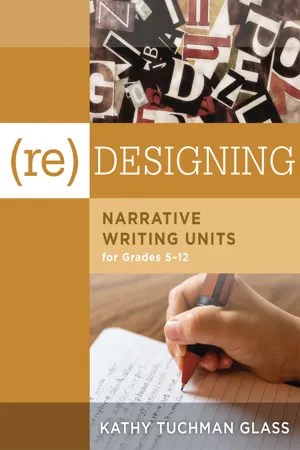
(Re)designing Narrative Writing Units for Grades 5-12
(Create a Plan for Teaching Narrative Writing Skills That Increases Student Learning and Literacy)
- 184 pages
- English
- ePUB (mobile friendly)
- Available on iOS & Android
(Re)designing Narrative Writing Units for Grades 5-12
(Create a Plan for Teaching Narrative Writing Skills That Increases Student Learning and Literacy)
About This Book
Teaching writing is a powerful and effective means for learning across all grade levels and disciplines. This user-friendly resource provides practical recommendations, strategies, and assessments for designing units of study that center on both narrative nonfiction and creative writing. Throughout the book, readers can complete exercises that equip them to create a comprehensive narrative unit of instruction that is ready to pilot. It also provides narrative activities, assessments, sample tasks, rubrics, checklists, writing sample resources, and more for fifth grade to high school.
Learn how to design and maintain a unit that improves students' narrative writing skills:
- Learn a sequential approach to building a narrative writing unit.
- Review how to structure a narrative.
- Reflect on past teaching approaches and revise for future narrative writing lesson plans.
- Download free templates, checklists, rubrics, and narrative writing activities useful for designing a narrative writing plan and guiding lessons.
- Access professional and student resources in print and online for understanding and teaching narrative writing.
Contents:
Introduction
Chapter 1: Building a Narrative Unit Map
Chapter 2: Formulating a Pre- and Culminating Assessment and Establishing Criteria for Success
Chapter 3: Enhancing Setting with Imagery Using Gradual Release of Responsibility
Chapter 4: Designing Lessons
Chapter 5: Studying an Author's Craft by Analyzing Text
Epilogue
Resource A: Narrative and Descriptive Characteristics and Associated Genres
Resource B: Elements of Literature
Resource C: Literacy Devices and Figurative Language
Frequently asked questions
Information
Table of contents
- Cover
- Title Page
- Copyright
- Acknowledgments
- Table of Contents
- About the Author
- Introduction
- Chapter 1: Building a Narrative Unit Map
- Chapter 2: Formulating a Pre- and Culminating Assessment and Establishing Criteria for Success
- Chapter 3: Using Gradual Release of Responsibility for Lesson Design in Action
- Chapter 4: Designing Lessons
- Chapter 5: Examining Text to Appreciate Content
- Epilogue
- Appendix A: Narrative and Descriptive Text Types
- Appendix B: Elements of Literature
- Appendix C: Literary Devices and Figurative Language
- Appendix D: Sentence Structure: Complex Sentences
- Appendix E: Professional and Student Resources
- Appendix F: List of Figures and Tables
- References and Resources
- Index